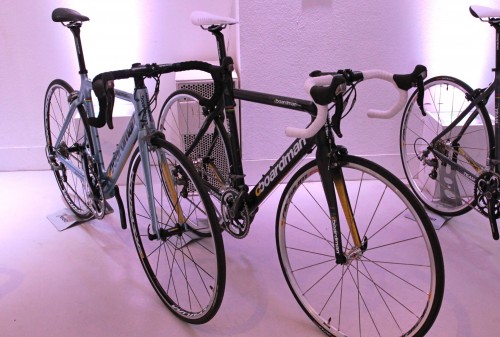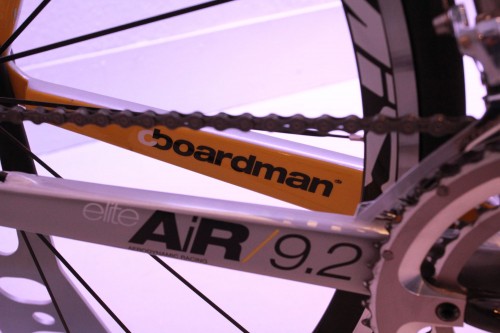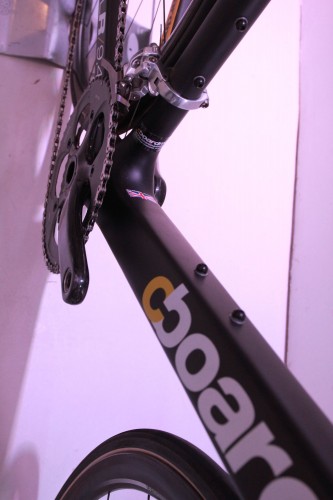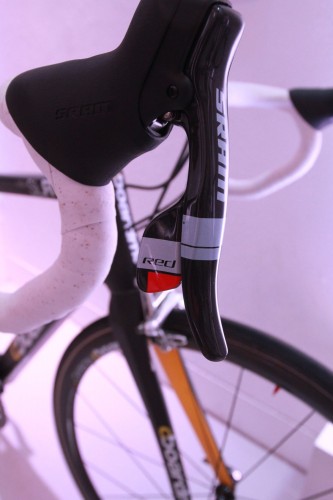- News
- Reviews
- Bikes
- Accessories
- Accessories - misc
- Computer mounts
- Bags
- Bar ends
- Bike bags & cases
- Bottle cages
- Bottles
- Cameras
- Car racks
- Child seats
- Computers
- Glasses
- GPS units
- Helmets
- Lights - front
- Lights - rear
- Lights - sets
- Locks
- Mirrors
- Mudguards
- Racks
- Pumps & CO2 inflators
- Puncture kits
- Reflectives
- Smart watches
- Stands and racks
- Trailers
- Clothing
- Components
- Bar tape & grips
- Bottom brackets
- Brake & gear cables
- Brake & STI levers
- Brake pads & spares
- Brakes
- Cassettes & freewheels
- Chains
- Chainsets & chainrings
- Derailleurs - front
- Derailleurs - rear
- Forks
- Gear levers & shifters
- Groupsets
- Handlebars & extensions
- Headsets
- Hubs
- Inner tubes
- Pedals
- Quick releases & skewers
- Saddles
- Seatposts
- Stems
- Wheels
- Tyres
- Health, fitness and nutrition
- Tools and workshop
- Miscellaneous
- Cross country mountain bikes
- Tubeless valves
- Buyers Guides
- Features
- Forum
- Recommends
- Podcast
TECH NEWS
First look:Boardman Air 9.4 aero road bike + super-light SLR 9.4 & new 2011/12 range
Boardman Bikes are really ramping things up for 2011/12 with new Elite and Performance ranges for the road. There are two new top-end carbon road frames plus a BB30 revamp for an old favourite. All that adds up to 14 new carbon models (and a top end TT bike on the way) plus new versions of their aluminium stalwarts the Road Team and the Road Comp. That's not all: there's also a new cyclocross bike and three new performance hybrids… and lots of BB30 bottom brackets.
Standout items look to be the the new Air aero road bikes, and the SLR lightweight machines… so that's all of the Elite range plus the new Road Pro Carbon which also uses the new AiR aero road frame, a new entry level road bike, the Road Race, and a very fancy looking performance hybrid, the Hybrid Pro.
In fact, every frame bar one, in both ranges, is new. There's none of yer new colours on last year's bikes here, which is why Boardman only do range launches every two years - when they've actually got something new to launch. Mind you, the new paint job option is a bit of a non-starter anyway given that Boardman's colour palette for their road bikes has not really strayed beyond either all black or all white with maybe the odd grey hybrid thrown in to the mix… until now. The 2011 road range sees a tentative step away from monochrome in the shape of the new Road Pro Carbon in what I'd be tempted to call blue steel.

The new road bikes will have a hard act to follow: Boardman made a real splash with their first range of road bikes when Nicole Cooke rode one to an Olympic Gold and World Championship double in 2008 - with Boardman offering the same frame decked out with different componentry for a mere £1,600 in the guise of the Pro Carbon. The Team Carbon uses the same mould but a different carbon lay up for £1,200.
Both machines were real benchmarks, and although the word 'classic' gets bandied around all too easily these days, these machines both have a claim on the word because not only do they combine superb value but they are corking bikes to ride too. No surprise, the,n that the Team Carbon lives on pretty much unchanged except for the addition of a BB30 bottom bracket.
Air 9.8, 9.4, 9.2

For 2011/12 Boardman roll out a greatly extended Elite range with a choice of two distinctive frames with three different builds for each. The AiR range of, yes, aero road bikes represents the biggest departure from what Boardman have done before.
Boardman weren't showing the range-topping AiR 9.8 used by their sponsored riders at the launch, but they did have the 9.4 and the 9.2. As far as we can see the only difference between the models is the spec packages. Oh, and the 9.4 is white. All share the same monocoque construction in high modulus carbon, with the pretty much compulsory asymmetric head tube and a full carbon fork.

According to the guys at Boardman, the AiR bikes are made with the demands of both the road racer and the triathlete in mind. There is a TT version in the pipeline so we will be intrigued to see if turns out to be same frame with tri bars etc. or a new frame – Boardman sponsors the triathlete Alistair Brownlee who will be riding an AiR this season.
The two top models come with deep section wheels. For the 9.8 that's Zipp 404 tubulars while the 9.4 gets 50mm cboardman carbon clinchers; the 9.2 gets Mavic Cosmic Elites. The frames themselves have been honed in the wind tunnel and the computer with great emphasis put on getting the most aero benefit out of real world conditions - cross winds and blustery gusts with the down tube, seat tube and seat post designed to deal efficiently with cross winds down to an angle of 20 degrees.

With the choice of SLR or AiR models, Boardman are following the current trend of dividing their performance ranges between aero road bkes and something for the weight weenies and climbers with an ultra-light model too. Aero road does seem to be the coming thing, but bike companies have spent a long time fostering the cycling world's obsession with weight so no surprise that there are plenty of people still more inclined to choose the lighter bike over the more aero option.
Not, it has to be said, that the AiR's can be considered in any way lardy – the AiR 9.8 weighs a claimed 15.4lb with the 9.4 coming in at 16.2lb and the 9.2 at 16.5lb; the claimed frame weight is a none-too-shabby 1.2kg. Aside from aero advantage, snappy, stable handling is also the name of the game here too. All of Boardman's bikes are designed to be stiff where they need to be. His work as chief tech guy for Team GB has left Chris Boardman a firm believer in the advantage of the BB30 bottom bracket system when it comes to transferring every ounce of pedalling effort to the back wheel as quickly as possible - no surprise then that FSA BB30 bottom brackets feature throughout his elite range of bikes and prominently in the performance range too.

Immediate power delivery to the back wheel is further aided by short, straight box section chainstays. One of the Boardman mantras is "the shortest distance between two points is a straight line" and every curve has to earn its place. There aren't many on the AiR bikes although all those straight lines are smoothed out with rounded edges which gives them a more organic look.

Flat surfaces on the inner faces of both front and rear forks are designed to work with deep section wheels and ensure that airflow smoothed by the wheel isn't disturbed by a more traditional rounder section fork blade. This approach is something you'll find on all the top aero road bikes including the Cervelo S3 to which, as has already been remarked, the Boardman's AiR frames bear a passing resemblance.
That shouldn't be too much of a surprise given that both are designs honed in the wind tunnel and, as has been said here before, given that the laws of physics are immutable it's more surprising that all aero optimised bikes don't look the same. What most of them do share is a deep section downtube, internal cable routing and a fair amount of melding together at the point where the top, down and head tubes meet. The AiRs are no different on that score.

In the flesh rather than a two dimensional picture, the differences between the Boardmans and the Cervelo S3 are more apparent. For a start, the S3 is much thinner in section. Where the junctions at the headtube on the AiRs is shorter and rounder front to back, the S3's is thinner and longer. Similarly, while the seastays on the AiRs might be thin, those on the S3 are positively skinny, and while they may share chunky, box section chainstays, those on the S3 don't have quite the same abrupt cut off before the dropout - which is something of a signature on the Boardmans. Also, it has to be said that while the AiR's chainstays are relatively short at 405mm, the S3's are shorter still at 390mm. By comparison, those on a Madone 6.9SSL are 410mm.
Another interesting wrinkle when it comes to stiffening up the chainstay and bottom bracket area is that instead of the bottom bracket shell being part of the front triangle of the bike with the stays plugging in at the back, Boardman design their new carbon frames with the bottom bracket as as an integral part of the rear triangle wth the seat tube and down tube plugging in to it. This, they reckon, adds stiffness and aids power transfer.
Not that Boardman really need to take a leaf out of anybody else's book here anyway. They have their own R&D depatment and in Chris Boardman they've got someone whose involvement with aero bikes goes back to Mike Burrows and that Olympic gold-winning Lotus and on through his later career as British Cycling's version of Q. Our guess is that Boardman are trying to combine the benefits of a quick, stable road bike with maximum aero slipperiness. We look forward to throwing a leg over one to see how well they've succeeded.

The AiR 9.8/9.4/9.2will be available in a choice of four sizes: S,M, L, XL. No pricing is available yet for the 9.8 but initial pricing for the other two is: A 9.4 should set you back £3,299.99 (less then the price of a Cervelo S3 frameset) while the 9.2 comes in at £2,299.99.
Given that we don't think there is a frame-only option available, I'd be pretty tempted by the 9.2. You get the same frame and fork as the 9.8 and 9.4, it comes with a mainly Shimano Ultegra drivetrain and controls with the addition of an FSA SLK BB30 chainset, and looks to be a nailed-on bargain that also gives you plenty of upgrade options...Although there is another option on that score, the Pro Carbon – top bike in the performance range – which is also built around an AiR frameset with Ultegra but Mavic Equipe wheels and an FSA Energy chainset for £1,799.99. Let's call it £1,800.
The 9.4 is pretty much the same mix as the 9.2 but with those cBoardman deep section wheels and Shimano Dura Ace instead of Ultegra. Interestingly, the 9.8 is decked out with SRAM Red rather than Shimano. We're not sure if this is to do with the sponsorship needs of the athletes that use the 9.8 or the need to keep the price of the overall package from going completely off the deep end. Boardman makes no secret of the fact that he is a fan of SRAM's top gruppo either.
SLR 9.8/9.4/9.2
 Boardman's SLR (Superlight Racing) frames are designed with "mountain passes and the hardest single day road races in mind". They are also designed to weigh less than the UCI weight limit – the SLR 9.8 has a claimed weight of a a feathery 14.2lb, with the 9.4 weighing in at 14.6lb and the 9.2 at 15.7lb. At the launch a straight from the box SLR 9.4 weighed 6.4kg. The difference between the two top models is all in the wheels because that seems to be the only spec difference between them. The 9.8 runs on Zipp 202s while the 9.4 runs cBoardman Carbon SLRs.
Boardman's SLR (Superlight Racing) frames are designed with "mountain passes and the hardest single day road races in mind". They are also designed to weigh less than the UCI weight limit – the SLR 9.8 has a claimed weight of a a feathery 14.2lb, with the 9.4 weighing in at 14.6lb and the 9.2 at 15.7lb. At the launch a straight from the box SLR 9.4 weighed 6.4kg. The difference between the two top models is all in the wheels because that seems to be the only spec difference between them. The 9.8 runs on Zipp 202s while the 9.4 runs cBoardman Carbon SLRs.

In many ways the SLRs are not that different from their AiR siblings. Both are designed to be all round race bikes, one with an emphasis on aero performance and the other on low weight. The handling characteristics and applications, though, are not designed to be massively different.
To my mind, the SLR looks to be a pared down version of the AiR. The geometry is the same, as is the method of constuction - Boardman have used finite element analysis to remove any excess material and tune the tube profiles for their intended use. Crucially, though, where there is a potential benefit across the range that benefit is applied, so the SLR has the same chainstays as the AiR and the non tapering to the rear dropout features prominently on a number of bikes.

One particular feature of the SLRs that we liked was the fact that although these bikes are light, with all frames a claimed sub 900g, they are also designed to be ridden by anybody - so there are no rider weight limits.

As with the AiRs, there are four frame sizes: S,M, L & XL. Prices on the 9.8SLR haven't been announced but the tbc price on the 9.4 is £3,299.99 and that gets you a full SRAM Red drivetrain and controls, those Boardman SLR wheels, and like the AiR Vittoria Corsa CX tyres – good to see decent tyres on a bike as original equipment too. The 9.2 sports SRAM Force instead of Red and swaps the CBoardman SLRs for Mavic Ksyriium Elite wheels and can be yours for £2,499.99.
Performance road, cyclocross and hybrids to follow…
road.cc's founder and first editor, nowadays to be found riding a spreadsheet. Tony's journey in cycling media started in 1997 as production editor and then deputy editor of Total Bike, acting editor of Total Mountain Bike and then seven years as editor of Cycling Plus. He launched his first cycling website - the Cycling Plus Forum at the turn of the century. In 2006 he left C+ to head up the launch team for Bike Radar which he edited until 2008, when he co-launched the multi-award winning road.cc - finally handing on the reins in 2021 to Jack Sexty. His favourite ride is his ‘commute’ - which he does most days inc weekends and he’s been cycle-commuting since 1994. His favourite bikes are titanium and have disc brakes, though he'd like to own a carbon bike one day.
Latest Comments
- Rendel Harris 1 sec ago
It was a bit more complex than that I think, the Badger had already been suffering from tendonitis for quite some time before (many said due to his...
- Bill H 42 min 30 sec ago
Watching Bradley Wiggins in the yellow jersey leading out Mark Cavendish on the Champs Elysees in 2012 is a standout sporting memory for me. Right...
- quiff 1 hour 8 min ago
That's going to life needlessly difficult when I want to (perfectly legitimately) filter through traffic or indeed get through my front door though...
- Car Delenda Est 1 hour 38 min ago
He's right: don't snitch
- Bmblbzzz 1 hour 44 min ago
Where are Zebedee and Ermintrude when you want them?
- Steve K 1 hour 57 min ago
Update on this: apparently it's all their Ti frames ever, except the HT Ti (no, no idea why). However, it's not transferable.
- Oldfatgit 2 hours 30 min ago
Cough *plotaroute.com*
- David9694 2 hours 41 min ago
Anger over Cornwall Council decision to offload 19 busy car parks...
- SimoninSpalding 4 hours 36 min ago
I have a Ragley Trig, which is steel, has masses of clearance plus everything needed for racks, mudguards. I have it set up with a 2x10 Campag...


















































































Add new comment
11 comments
"Boardman made a real splash with their first range of road bikes when Nicole Cooke rode one to an Olympic Gold and World Championship double in 1998" 2008 maybe?
Sorry to be predantic.... Actually, I'm not. I thrive on it
great value bikes but you pay by having monkeys put them together (in the examples Ive come accross at least) and thus the owner ends up going to their LBS to get it put together properly and doesnt return to halfords or boardman.
Still no getting away from the success theyve had and the value they offer though.
Looking at the specs on their website, it's disappointing that it's only the lower spec ones that come with compact cranksets. And there's a prevalence of tubular wheels. While some people will want that not sure it suits most of the market.
,
If youre in the market for what looks like pro quality bike id presume most people would have multiple sets of wheels and a winter bike already so would save the tubs for racing or special days and do winter training on a different bike with easier gears.
Also you save so much compared to the competition that even if you dont have a pair of training wheels you could still justify splashing out.
Cant wait to see the price of 9.8 Id love a bike like that and a pair of zipps.
Nice to see the new range, I'm quite pleased I got one of the current Team Carbons though, as I think that the SRAM Rival groupset is a better package than the 105, even without the Rival Brakes..
As a matter of interest, I have a set of nearly new Mavic Aksiums from my previous bike, would you say these are better than the Ritchey Pros that come as standard on the old Team Carbon ? I dont know whether to swap them or not..
The Air 9.4 in WHITE is stunning. If only the frame was cheaper than the brilliant Cervelo s3, any non pros would have cried for joy. But here the color scheme is better. The graphics are a stoke of genius. I love it!
Really refreshing to see a manufacturer who updates their website at the same time as their press events!
those lb weights were what Boardman were quoting at the launch, I'm always slightly wary of converting such weights in to metric if I didn't take 'em myself because they are going to be rounded slightly up or down and also because of a nagging doubt lbs expressed as a decimal measurement - even though we do it all the time here.
I find it really odd that bike and frame weights often get quoted in pounds in reviews, alongside other components which are invariably metric. I wouldn't have any qualms about converting lb to kg. kg to two decimal places will be accurate enough, or just make sure you have the same number of significant figures. I end up typing conversions into Google Calculator.
The 9.2 SLR would be my pick. SRAM Force and reliable Ksyriium Elite wheels.
Really great range of bikes.
BTW, what are these "lb" weights? They don't mean anything to me!